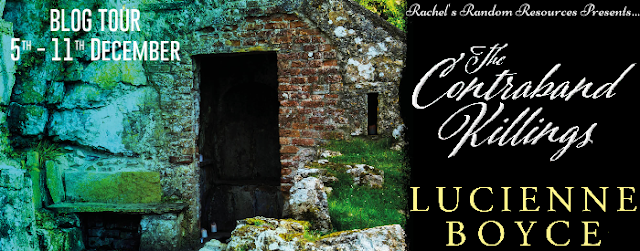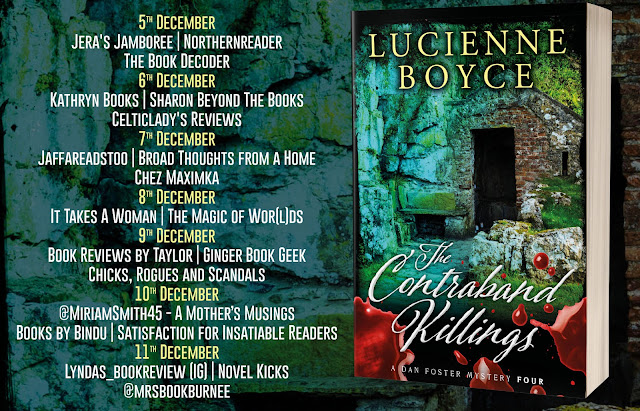I'm thrilled to invite Lucienne Boyce to my blog. Today she is talking about walking holidays in the 18C. Are you intrigued? Scroll down to find out more.
The Contraband
Killings: A Dan Foster Mystery
Principal Officer Dan Foster
of the Bow Street Runners is sent to collect smuggler Watcyn Jones from
Beaumaris Gaol on Anglesey, and bring him back to London for trial at the Old Bailey.
As if having to travel to the wilds of North Wales isn’t bad enough, Dan is
saddled with an inexperienced constable as his interpreter and assistant. At
least it’s a routine assignment and shouldn’t take more than a few days.
But when the prison escort is
ambushed and Watcyn Jones escapes, a straightforward transfer turns into a
desperate manhunt. And as Jones’s enemies start to die, the chase becomes more
urgent than ever. Dan’s search for the killer brings him up against a ruthless
smuggling gang – and his chances of getting off the island alive begin to look
far from promising.
Purchase Links
US - https://www.amazon.com/gp/product/B0BFRRSD72
UK - https://www.amazon.co.uk/gp/product/B0BFRRSD72
Author Bio –
Lucienne
Boyce writes historical fiction, non-fiction and biography. After gaining an MA
in English Literature, specialising in eighteenth-century fiction, she
published her first historical novel, To The Fair Land (2012,
reissued 2021), an eighteenth-century thriller set in Bristol and the South
Seas.
Her
second historical novel, Bloodie Bones: A Dan Foster Mystery (2015,
reissued 2022) is the first of the Dan Foster Mysteries and follows the
fortunes of a Bow Street Runner who is also an amateur pugilist. Bloodie
Bones was joint winner of the Historical Novel Society Indie Award
2016, and was also a semi-finalist for the M M Bennetts Award for Historical
Fiction 2016. The second Dan Foster Mystery, The Butcher’s Block (2017,
reissued 2022), was awarded an IndieBrag Medallion in 2018. The third in the
series, Death Makes No Distinction (2019, reissued 2022), is
also an IndieBrag Medallion honoree, recipient of Chill With a Book Premium
Readers’ Award, and a joint Discovering Diamonds book of the month. In 2017 an
e-book Dan Foster novella, The Fatal Coin, was published by
S-Books. The Fatal Coin is now available in paperback.
The
Bristol Suffragettes, a history of the
suffragette campaign in Bristol and the South West of England, was published in
2013. In 2017 Lucienne published a collection of short essays, The Road
to Representation: Essays on the Women’s Suffrage Campaign.
Other
Publications
‘Not
So Militant Browne’ in Suffrage Stories: Tales from Knebworth,
Stevenage, Hitchin and Letchworth (Stevenage Museum, 2019)
‘Victoria
Lidiard’ in The Women Who Built Bristol, Jane Duffus (Tangent Books,
2018)
‘Tramgirls,
Tommies and the Vote’ in Bristol and the First World War: The Great
Reading Adventure 2014 (Bristol Cultural Development
Partnership/Bristol Festival of Ideas, 2014)
Social Media
Website: www.lucienneboyce.com
Blog: https://francesca-scriblerus.blogspot.com/
Twitter:
@LucienneWrite
Pinterest: https://www.pinterest.co.uk/LucienneBoyceWriter/
Good Reads: http://www.goodreads.com/author/show/6437832.Lucienne_Boyce
A Pedestrian in Wales (guest post by Lucienne Boyce)
In The Contraband Killings Bow Street Runner Dan Foster, who is looking for an escaped prisoner on Anglesey, visits the famous copper mine on Parys Mountain. While there, he sees a group of tourists on a tour of the works. Among them is a young man who is making a sight-seeing journey through Wales on foot.
Walking holidays – or pedestrian tours as they were known – were very popular with English holiday makers in the eighteenth century. Not only were they cheaper than travelling by coach, they were healthy, and gave the traveller the notion that he was seeing more than the average traveller bowling through the country in his stagecoach. Since very few of the tourists could speak Welsh, they were usually deluding themselves about how much they understood about the places they visited and the people they saw.
But travellers will be travellers, and one thing many of them love to do is write a book about their adventures when they get home. The pedestrians of the eighteenth century were no exception, and there was an outpouring of ‘walks’, ‘tours’ and ‘pedestrian tours’ through Wales. I read some of these when I was researching The Contraband Killings.
Travellers went to Wales for a variety of reasons. Many went seeking picturesque and awe-inspiring landscapes. Those who fancied themselves as artists could consult the Welsh artist Edward Pugh’s Cambria Depicta: A Tour Through North Wales Illustrated With Picturesque Views (1816) which set out an artist’s itinerary. Pugh guided artists to “the mountain’s craggy side, the cwm’s solemn profundity, the frightful brink of the cataract…and the tufted banks of the serpentine afon”. Pugh, who was born in Ruthin, was a Welsh speaker, and liked to throw in the occasional Welsh word. He advised on the best outlooks; encouraged his readers to visit some of the less-known places – Conway Castle had been “repeatedly painted” and “from the same spot”; and told them which places weren’t worth their trouble: “The shore from hence to Holyhead is very tame, and offers nothing for the pencil”.
Others went seeking Druidical ruins. One of these was the Reverend John Skinner of Somerset, who described his excursion with his brother Russell in his Ten Days’ Tour Through the Isle of Anglesey. They crossed to the island in the tracks of the Roman governor Gaius Suetonius Paulinus whose troops attacked Anglesey; Boudica staged her rebellion while he was busy slaughtering Druids. Skinner sketched earthworks, standing stones and the prehistoric burial chamber at Plas Newydd (now owned by the National Trust); poked about in Bryn Celli Ddu burial chamber, disturbing nests of “immense spiders”; and copied out inscriptions he found in churches and on gravestones.
Many budding mineralogists went to Wales: Pugh had promised his Cambria Depicta would also cater for their interests. The Reverend Richard Warner, who went with a friend on “A Walk Through Wales, in August 1797”, mentions collecting “good mineralogical specimens”. 107 Alongside his observations of ruins and landscapes, the Reverend also had an eye for the ladies. Clapping eyes on an innkeeper’s daughter near Dolgelly he noted “we had scarcely ever seen a girl more lovely or interesting”.
Others, as Pugh noted, went seeking “characters”: the Infant Hercules, eight years old, four feet two inches tall, and weighing nine stone; the witch Sian Bwt; Cady Thomas, the bearded lady; and bed-ridden Mary Thomas who had not eaten for seven years. Collecting – and where possible correcting – local superstitions was also popular with travellers. When Reverend Warner’s guide blamed his lameness on witchcraft, the Reverend tried to convince him his injury was due to natural causes.
Skinner recorded tales of buried treasure, haunted stones, ignis fatuus, fairies and the “knockers” in the mines who led the miners to ore. He mocked the superstition of the “ignorant and illiterate”, and the ignorant and illiterate mocked back. The brothers went out in all weathers – rain, sleet, hail – and incurred “the ridicule of two old women who enjoyed a hearty laugh at our walking in the rain to hunt after stones”.
But the young pedestrian in The Contraband Killings who attracts Dan’s attention has more than innocent tourism in mind, and it’s up to Dan to find out what murky deed he’s plotting…
Lucienne Boyce
November 2022
www.lucienneboyce.com





Thank you for having me on your blog and for being part of the blog tour.
ReplyDelete